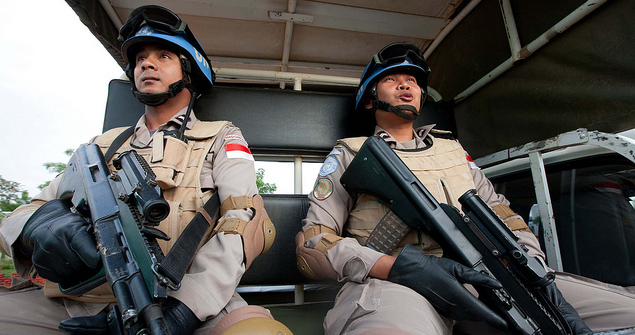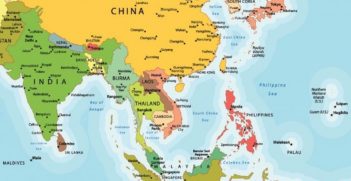Resilience Will Blunt Islamic State's Potential in Indonesia

The risk to Indonesia of returned fighters is less today than it was fifteen years ago.
With the brutality of Islamic State in Syria and Iraq on show to the world, there is concern over violence being exported, should foreign fighters return to their home countries. For Indonesians, this threat recalls painful memories of Al Qaeda-inspired violent jihad being committed against the nation after fighters returned home from Afghanistan. However, on closer inspection is it unlikely that the conflict in the Middle East today will pose the same mode of threat to Indonesia as the conflict in Afghanistan did during the 2000s.
Islamic State, commonly referred to as IS, has been attracting fighters from all over the world to fight in Syria and Iraq, in much the same way that fighters flocked to Afghanistan in the 1990s to defend against the Soviet invasion. The number of Indonesian fighters who travelled to the Middle East is unclear, but is likely to far outnumber the 300 or so who fought and trained in Afghanistan. Considering the consequences of fighters returning from Afghanistan held for Indonesia’s security, the potential for a mass return of fighters from the Middle East is of some concern.
Under President Suharto, Islamists were persecuted as a threat to the New Order government. Many were exiled. The 1979 Soviet invasion of Afghanistan attracted many of the exiled Indonesians as Islamic defenders who, after the Soviets were expelled, found their way into Al Qaeda terrorist training camps. When President Suharto stepped down in 1998, an opportunity arose for the exiled to return. Those returning from Afghanistan carried with them Al Qaeda’s “Jihadist International” ideology, enhanced capabilities and the rejuvenated agenda for an Islamic Indonesian state.
Over a number of years, this new wave of jihadists and their followers carried out high profile attacks on tourist hotspots, foreign embassies and five star hotels, among others. The intent was to attack and cast out secular Westerners and, at the same time, delegitimize the secular Indonesian government instigating an Islamic revolution. Whilst the attempt failed, the destruction caused along the way was costly.
Indonesian Islamists are now traveling to fight in the Middle East and there is a risk that the destruction and instability of the 2000’s will be revisited. But it is unlikely that Indonesia will see a return to the bad old days of violent jihadism, if and when fighters return from Syria and Iraq.
As the Al Qaeda trained fighters filtered into Indonesia in the late 1990s, the country was pre-occupied with the downfall of a dictator, communal violence and armed independence movements. The nation was fracturing; the state was weakened. The ability to detect infiltration by trained individuals was very limited, as was the ability to combat it. The same cannot be said for Indonesia today.
As a response to the 2002 Bali Bombings, the Indonesian police formed Detachment 88 (Densus 88) to combat terrorism. With Australian and American assistance, Densus 88 has been effective in combating violent jihadism, often with fearful enthusiasm, so much so that the jihadists have splintered into smaller groups struggling just to exist.
The militants in Indonesia who remain free and alive are carrying out assassinations of individual police officers and attacking local police stations. These actions may be interpreted as direct attacks upon the state, with the goal of its eventual destruction. However, given the same room to act as was available to jihadists in the 2000s, it is likely that the targets they’d choose would be Indonesia’s parliament and key politicians as well as the headquarters of Densus 88 and Police. Attacking individual police and their facilities at the local level achieves little in pursuit of their strategic goal. It is more likely that they are attacking the local police because their room to act has been greatly constrained and they are attacking those who are pursuing them.
Any fighters returning from the Middle East are likely to find themselves in the same position and unable to launch the strategic level attacks perpetrated by those who returned from Afghanistan in the 2000s.
In addition to better prepared security services, fighters returning from Syria and Iraq will also find a society less prepared to accept their extreme ideology. Indonesia’s largest Islamic organisations, Muhammadiyah and Nahdlatul Ulama, are ubiquitous in Indonesian society and are powerful in terms of resources and influence. Neither organisation is ideologically disposed to the Islamic State message but both risk losing their power should IS gain widespread support in Indonesia. To this end, both organisations are actively undermining IS’s propaganda and message within the country and are working to detect it should it take root within their constituencies. Nahdlatul Ulama is also creating and managing a program to deradicalise fighters returning from the Middle East, to prevent them proselytizing the IS message or conducting attacks in its name.
As Indonesia has increased its capability to combat terrorism returning fighters’ capacity to carry out terrorist attacks has been reduced. After the Soviets were repelled from Afghanistan, the Islamic fighters led by Osama bin Laden turned their attention to exporting jihadism to the world in the form of terrorism. Many of the jihadists that left Afghanistan were trained in skills such as covert operations (operating in independent cells, communicating undetected, identification and surveillance of targets) and high profile attacks creating fear (covert acquisition of bomb making material and bomb construction, successful deployment of explosive attacks, etc.). These are the skills of a modern terrorist, but are not the skills being taught to those fighting in Syria and Iraq today.
The Syrian and Iraqi conflicts are of a hybrid guerrilla/conventional nature. Islamic State forces are using firepower and manoeuvre to take and hold ground with the aim of replacing existing states. The skills typical of an IS fighter are that of the common conventional soldier – employment of small arms, operation of artillery and armour and general vehicle handling. These are not the skills required to carry out large-scale terrorist attacks like those experienced in Indonesia throughout the 2000’s. Infantry-level fighters returning from Syria and Iraq, wishing to continue the fight, will be more likely to carry out attacks relative to their training and experience. Attacks like those seen against the offices of Charlie Hebdo in Paris, the National Bardo Museum in Tunis, the Westgate Shopping Mall in Kenya, the attack on the Jewish Museum of Belgium and even the Lindt Café siege in Sydney are the kind more likely to be attempted by fighters returning from the Middle East.
Infantry-level attacks are shocking, destructive and attract massive media attention. However they do not pose a strategic level threat to Indonesia. The overwhelming response after the Paris and Sydney attacks was revulsion. Islamic State has so far generated very little support in Indonesia and low-level attacks on soft targets such as shopping centres, bars and hotels targeting civilians are more likely to disgust and repulse the average Indonesian than attract people to the IS message.
This is not to suggest that returning fighters pose no threat to Indonesia, nor that any attack is unlikely. It is likely that Indonesia will experience further jihadi-based violence, some of it attributable to fighters returning from Syria and Iraq. However given the difference in circumstances between fighters returning from Afghanistan and the Middle East, and the level of preparation in Indonesia to combat terrorism, it is unlikely that Indonesia will see a return to the levels of violence experienced in the 2000s.
Chris Farnham is the National Office Operations Manager for the Australian Institute of International Affairs with a professional background in security and strategic analysis. This article can be republished with attribution under a Creative Commons Licence.





